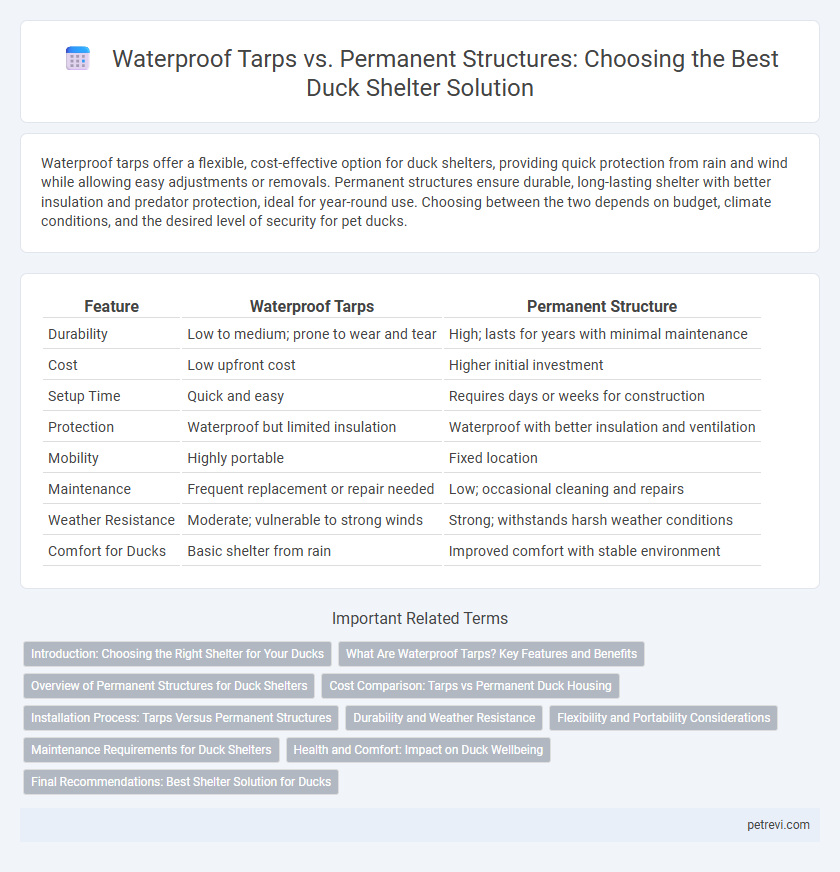Waterproof tarps offer a flexible, cost-effective option for duck shelters, providing quick protection from rain and wind while allowing easy adjustments or removals. Permanent structures ensure durable, long-lasting shelter with better insulation and predator protection, ideal for year-round use. Choosing between the two depends on budget, climate conditions, and the desired level of security for pet ducks.
Table of Comparison
| Feature | Waterproof Tarps | Permanent Structure |
|---|---|---|
| Durability | Low to medium; prone to wear and tear | High; lasts for years with minimal maintenance |
| Cost | Low upfront cost | Higher initial investment |
| Setup Time | Quick and easy | Requires days or weeks for construction |
| Protection | Waterproof but limited insulation | Waterproof with better insulation and ventilation |
| Mobility | Highly portable | Fixed location |
| Maintenance | Frequent replacement or repair needed | Low; occasional cleaning and repairs |
| Weather Resistance | Moderate; vulnerable to strong winds | Strong; withstands harsh weather conditions |
| Comfort for Ducks | Basic shelter from rain | Improved comfort with stable environment |
Introduction: Choosing the Right Shelter for Your Ducks
Waterproof tarps offer a flexible and cost-effective solution for duck shelters, providing quick protection against rain and wind. Permanent structures made from durable materials ensure long-term safety, insulation, and stability, minimizing maintenance over time. Evaluating factors such as climate, budget, and intended shelter lifespan is essential for selecting the optimal housing option for ducks.
What Are Waterproof Tarps? Key Features and Benefits
Waterproof tarps are durable, water-resistant sheets made from materials like polyethylene or vinyl designed to provide temporary protection for duck shelters. Key features include UV resistance, tear strength, and ease of setup, which help shield ducks from rain, wind, and harsh weather conditions. Their flexibility and affordability make waterproof tarps a practical choice for seasonal or emergency shelter needs compared to permanent structures.
Overview of Permanent Structures for Duck Shelters
Permanent structures for duck shelters provide robust protection against harsh weather, ensuring durability and long-term safety for the flock. Constructed from materials such as wood or metal, these shelters offer stable insulation and ventilation, reducing risk of predators and illness. Their design allows for easy cleaning and maintenance, promoting optimal hygiene and comfort for ducks throughout the year.
Cost Comparison: Tarps vs Permanent Duck Housing
Waterproof tarps offer an affordable initial investment for duck shelters, typically costing between $20 to $100 depending on size and quality, whereas permanent duck housing structures can range from $300 to over $1,000 due to materials and labor. Tarps provide temporary protection against rain and wind but may require frequent replacement, increasing long-term expenses. Investing in permanent housing, though higher upfront, reduces maintenance and enhances durability, ultimately offering better cost-efficiency over several years.
Installation Process: Tarps Versus Permanent Structures
Waterproof tarps offer a quick installation process for duck shelters, requiring minimal tools and basic securing methods such as ropes or bungee cords. In contrast, permanent structures demand more extensive groundwork, including framing, anchoring, and possible permits, resulting in a longer setup time. The simplicity of tarp installation favors temporary or seasonal use, while permanent shelters provide durable protection but with increased labor and cost.
Durability and Weather Resistance
Waterproof tarps offer a flexible, cost-effective solution for duck shelters that can be easily replaced or adjusted, but their durability is limited under prolonged exposure to harsh weather conditions, often lasting one to two seasons. Permanent structures built with treated wood and weather-resistant materials provide superior durability and consistent protection against wind, rain, and snow, ensuring long-term shelter stability. While tarps provide quick coverage, permanent shelters excel in maintaining a dry, safe environment crucial for ducks' health during extreme weather.
Flexibility and Portability Considerations
Waterproof tarps offer exceptional flexibility and portability for duck shelters, allowing easy setup, relocation, and storage based on changing weather or habitat needs. Unlike permanent structures, tarps can be quickly adjusted or removed, providing adaptable protection against rain, wind, and predators. Their lightweight and compact nature makes tarps an ideal choice for temporary or seasonal shelter solutions in diverse environments.
Maintenance Requirements for Duck Shelters
Waterproof tarps require frequent inspections and prompt repairs to prevent leaks and ensure effective protection against rain and wind for duck shelters. Permanent structures, constructed with durable materials like wood or metal, demand less frequent maintenance, typically involving periodic cleaning and repainting to preserve structural integrity. Choosing between waterproof tarps and permanent shelters depends on the balance between maintenance effort and long-term durability for optimal duck housing.
Health and Comfort: Impact on Duck Wellbeing
Waterproof tarps provide flexible and breathable protection for ducks, reducing moisture buildup and minimizing the risk of respiratory issues. Permanent structures offer consistent shelter from harsh weather, ensuring stable temperature and protection from predators, which enhances overall duck wellbeing. Proper ventilation in either option is crucial to prevent dampness and maintain a healthy environment for optimal duck comfort and health.
Final Recommendations: Best Shelter Solution for Ducks
Waterproof tarps offer a flexible, cost-effective shelter option that protects ducks from rain and wind but may require frequent replacement and lack insulation. Permanent structures provide durable, well-insulated protection with better ventilation, enhancing duck comfort and health, though they demand higher initial costs and maintenance efforts. For long-term duck welfare and habitat stability, investing in a permanent shelter proves to be the optimal solution.
Waterproof Tarps vs Permanent Structure for Duck Shelter Infographic

 petrevi.com
petrevi.com